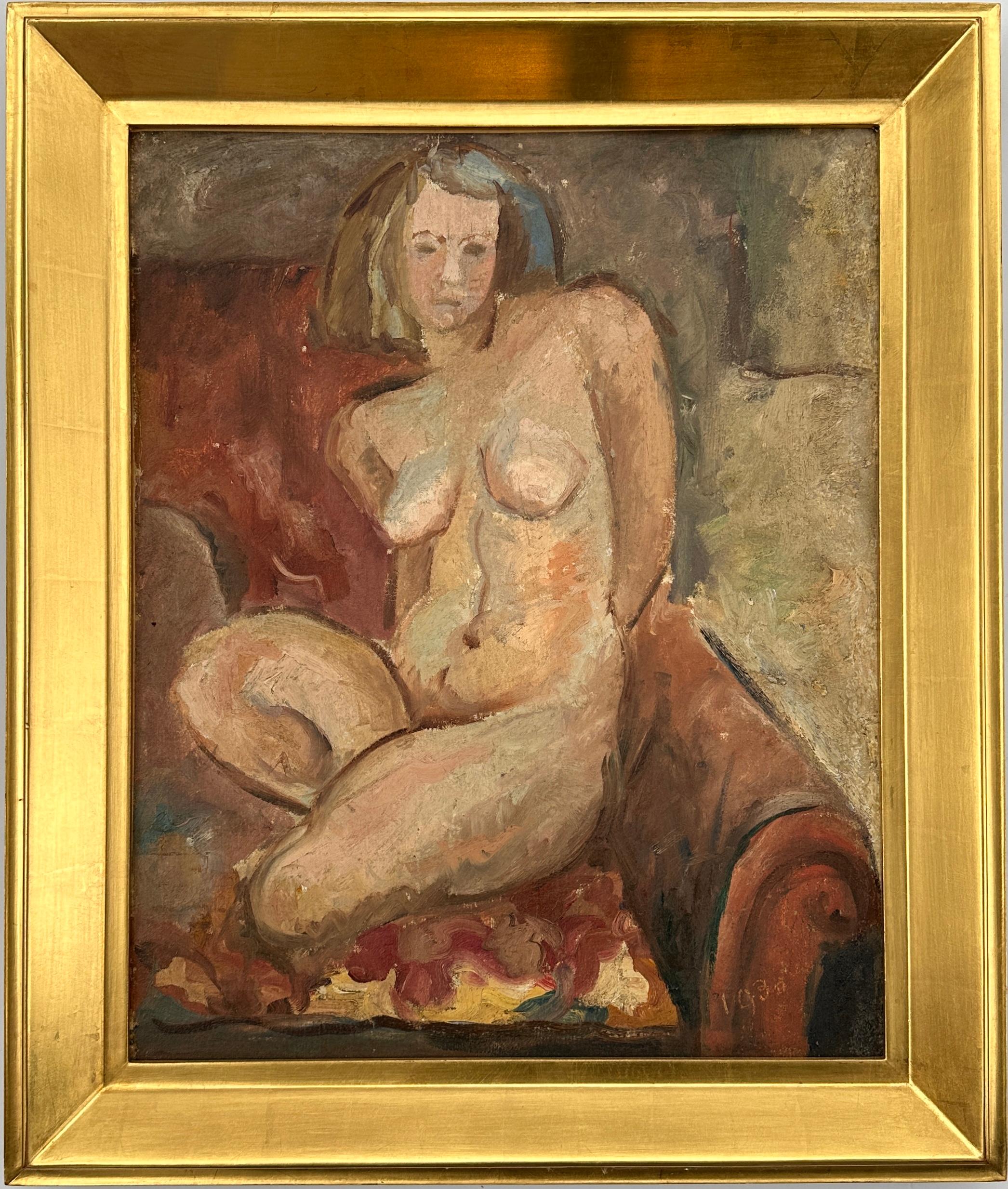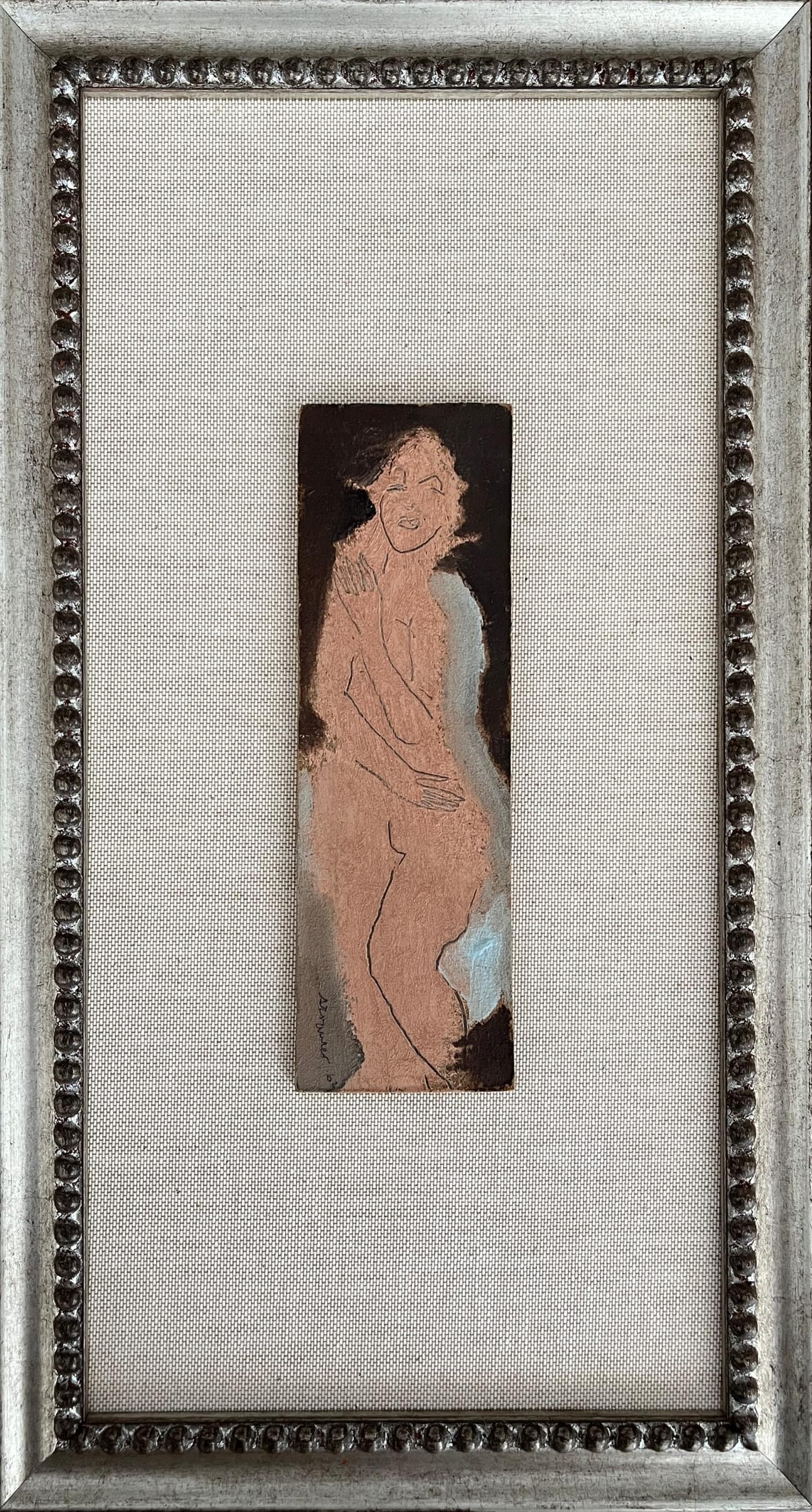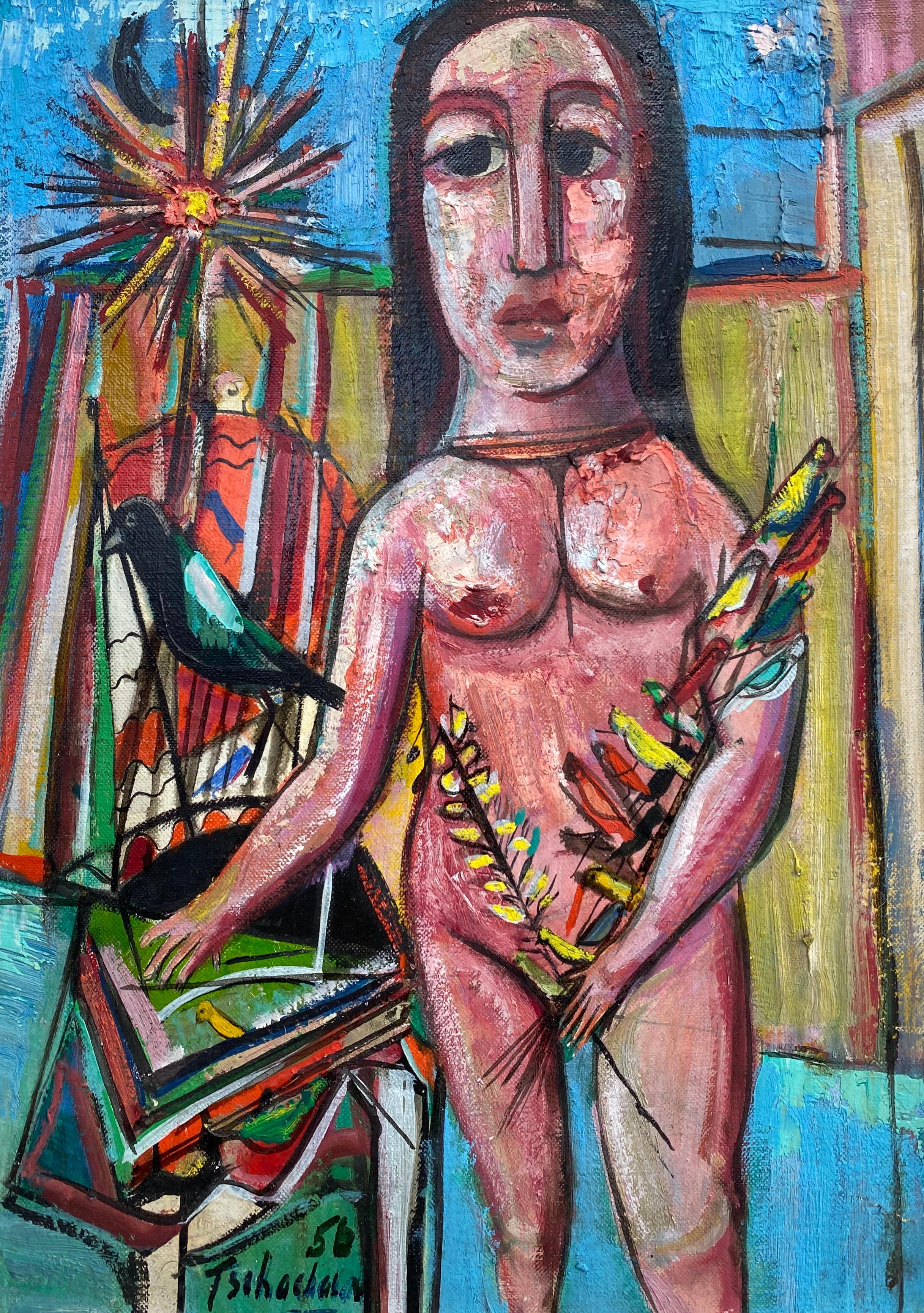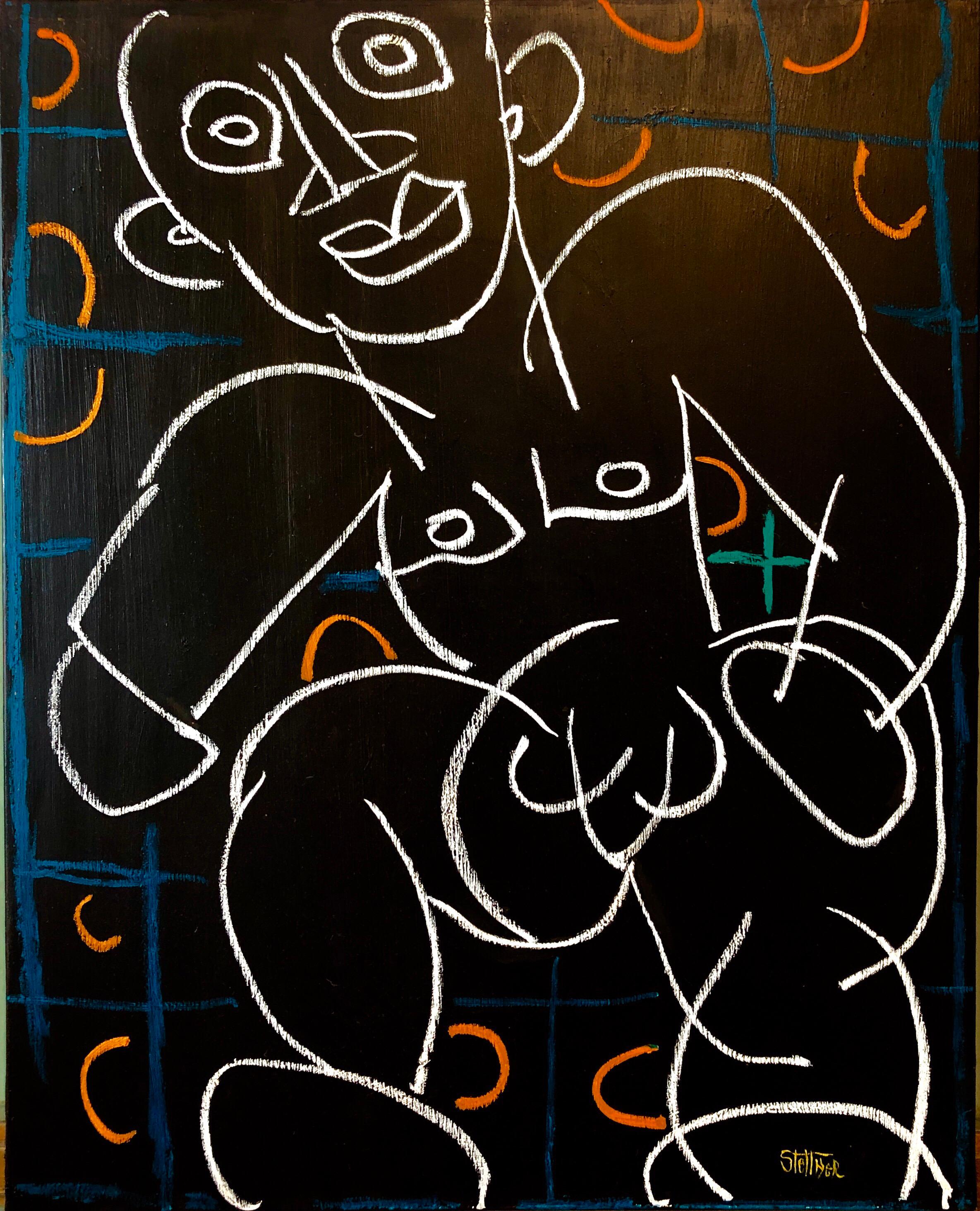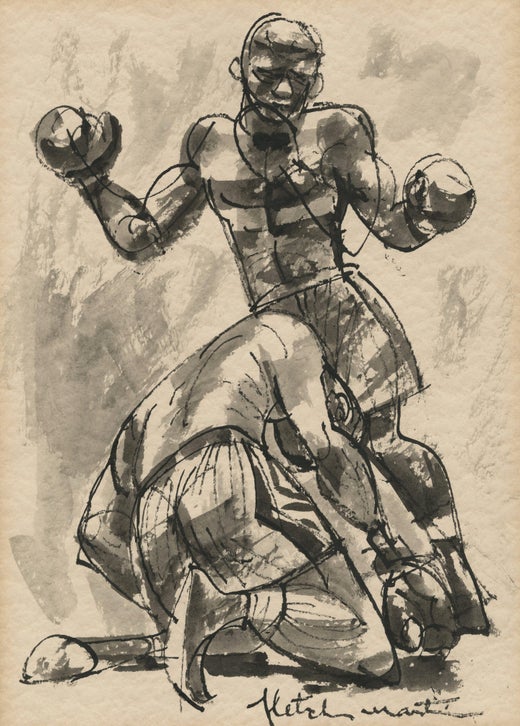Items Similar to Nude with Drape
Want more images or videos?
Request additional images or videos from the seller
1 of 5
Fletcher MartinNude with Drape
About the Item
Nude with Drape, c. 1937, oil on board, 24 x 17 (oval), signed lower right, provenance: Frances Lee Kent Falcone Family Trust
About the Painting
Fletcher Martin’s Nude with Drape is a very modern take on one of the oldest subjects in western art, the female nude. In this work, we see the structural influence of Cezanne, the artist who meant the most to Martin, the impact of Surrealism, and the classical ordering of De Chirico. When discussing American Surrealism in his essay American Art Today for the catalog of the art exhibition at the 1939 New York World’s Fair, Holger Cahill noted, “The surrealists cultivate the fantastic, the mysterious and even the macabre, and their work has been colored to a considerable extent by the ideas of the psychoanalysts. While they stress spontaneous and untrammeled personal expression to the point of irrationality, they have shown a great deal of aptitude for technical discipline. They have a way of painting the most bizarre subject matter in the driest and most deliberate academic technique. Straight surrealism, as practiced by the European adept, has not proved attractive to many American artists . . . . however, a good many of the works exhibited indicated that surrealist ideas and technique have been assimilated into the stream of contemporary American expression.” The assimilation and technical virtuosity described by Cahill is what we find in Nude with Drape.
About the Artist
Fletcher Martin was a well-respected artist, illustrator and teacher who worked in a variety of media. Born in Colorado, Martin was largely self-taught. He initially served in the Navy before moving to Los Angeles where he was represented by the Hatfield Gallery and had his first solo museum show at the San Diego Fine Arts Gallery in 1934. Martin and his work are associated with some of the most prominent artists of the 20th century.He was an assistant to Siquieros and followed both Grant Wood and Thomas Hart Benton in their teaching assignments at the University of Iowa and the Kansas City Art Institute, respectively. Martin spent decades teaching at other institutions, including the Art Students League in New York and Mills and Claremont Colleges, both in California. Martin exhibited extensively during the 1930s and 1940s at every major institution in the US, including the Museum of Modern Art (New York), the Los Angeles County Museum of Art and the Whitney Museum of American Art. His paintings received numerous awards and strong critical response.He completed several WPA and Federal Art Project Commissions, including a fresco for Hollywood High School and a mural for the Federal Building in San Pedro, California. Martin’s works are in the collections of over two dozen museums, including the Metropolitan Museum of Art (New York), the Museum of Modern Art (New York), the Whitney and LACMA.He is extensively listed in Who was Who in American Art and all other standard references.
- Creator:Fletcher Martin (1904-1979, American)
- Dimensions:Height: 17 in (43.18 cm)Width: 24 in (60.96 cm)Depth: 1 in (2.54 cm)
- More Editions & Sizes:26.5 x 33.2 x 2 inches (framed)Price: $20,000
- Medium:
- Movement & Style:
- Period:
- Condition:
- Gallery Location:Los Angeles, CA
- Reference Number:1stDibs: LU1859210062642
Fletcher Martin
Fletcher Martin was an American painter, illustrator, muralist and educator. He is best known for his images of military life during World War II and his sometimes brutal images of boxing and other sports. Martin was born in 1904 in Palisade, Colorado, one of seven children of newspaperman Clinton Martin and his wife Josephine. The family relocated to Idaho and later Washington. By the age of 12, he was working as a printer. He dropped out of high school and held odd jobs such as lumberjack and professional boxer. He served in the U.S. Navy, 1922–26. Martin's artistic skills were largely self-taught.
About the Seller
No Reviews Yet
Vetted Seller
These experienced sellers undergo a comprehensive evaluation by our team of in-house experts.
1stDibs seller since 2022
6 sales on 1stDibs
Typical response time: 2 hours
- ShippingRetrieving quote...Ships From: Los Angeles, CA
- Return PolicyA return for this item may be initiated within 3 days of delivery.
More From This SellerView All
- Untitled (Elevated Platform)Located in Los Angeles, CAThis painting is part of our current exhibition - America Coast to Coast: Artists of the 1940s Untitled (Elevated Platform), 1950, oil on canvas, signed and dated lower right, 30 x...Category
1950s American Modern Paintings
MaterialsCanvas, Oil
- Riders of Pigeon HillBy Jon CorbinoLocated in Los Angeles, CARiders of Pigeon Hill, c. 1940s, oil on canvas, signed lower right, 24 x 36 inches, label verso with title, artist’s name and address; same information inscribed verso; ex-collection...Category
1940s American Modern Paintings
MaterialsCanvas, Oil
- Untitled (Transcendental Composition)By Charles Ragland BunnellLocated in Los Angeles, CAThis work is part of our exhibition - America Coast to Coast: Artists of the 1940s Untitled (Transcendental Composition), oil on board, 1947, oil on board, signed and dated lower r...Category
1940s American Modern Paintings
MaterialsOil, Board
- Fallen Comrades/InterludeLocated in Los Angeles, CAThis work is part of our exhibition - America Coast to Coast: Artists of the 1940s Fallen Comrades/Interlude, 1949, oil on masonite, signed lower left, 35 x 56 inches; Gallery Z la...Category
1940s American Modern Paintings
MaterialsMasonite, Oil
- The Landing/Dawn LandingLocated in Los Angeles, CAThis painting is part of our exhibition America Coast to Coast: Artists of the 1940s. The Landing/Dawn Landing, 1944, oil on canvas, signed lower left, 20 x 30, titled verso; exhib...Category
1940s American Modern Paintings
MaterialsCanvas, Oil
- Subway ConstructionLocated in Los Angeles, CAThis painting is part of our exhibition American Coast to Coast: Artists of the 1930s Subway Construction, c. 1928, oil on board, 19 x 15 ¾ inches, signed upper left, artist and title verso; exhibited: 1) 12th Annual Exhibition of the Society of Independent Artists, The Waldorf Astoria, New York NY, from March 9 to April 1, 1928, no. 864 (original price $250) (see Death Prevailing Theme of Artists in Weird Exhibits, The Gazette (Montreal, Quebec, Canada), March 8, 1928); 2) Boston Tercentenary Exhibition Fine Arts and Crafts Exhibition, Horticultural Hall, Boston MA, July, 1930, no. 108 (honorable mention - noted verso); 3) 38th Annual Exhibition of American Art, Cincinnati Art Museum, Cincinnati, OH, June, 1931 (see Alexander, Mary, The Week in Art Circles, The Cincinnati Enquirer, June 7, 1931); and 4) National Art Week Exhibition [Group Show], Montross Gallery, New York, New York, December, 1940 (see Devree, Howard, Brief Comment on Some Recently Opened Exhibitions in the Galleries, The New York Times, December 1, 1940) About the Painting Ernest Stock’s Subway Construction depicts the excavation of New York’s 8th Avenue line, which was the first completed section of the city-operated Independent Subway System (IND). The groundbreaking ceremony was in 1925, but the line did not open until 1932, placing Stock’s painting in the middle of the construction effort. The 8th Avenue line was primarily constructed using the “cut and cover” method in which the streets above the line were dug up, infrastructure was built from the surface level down, the resulting holes were filled, and the streets reconstructed. While many artists of the 1920s were fascinated with the upward thrust of New York’s exploding skyline as architects and developers sought to erect ever higher buildings, Stock turned his attention to the engineering marvels which were taking place below ground. In Subway Construction, Stock depicts workers removing the earth beneath the street and building scaffolding and other support structures to allow concrete to be poured. Light and shadow fall across the x-shaped grid pattern formed by the wooden beams and planks. It is no surprise that critics reviewing the painting commented on Stock’s use of an “interesting pattern” to form a painting that is “clever and well designed.” About the Artist Ernest Richard Stock was an award-winning painter, print maker, muralist, and commercial artist. He was born in Bristol, England and was educated at the prestigious Bristol Grammar School. During World War I, Stock joined the British Royal Air Flying Corps in Canada and served in France as a pilot where he was wounded. After the war, he immigrated to the United States and joined the firm of Mack, Jenny, and Tyler, where he further honed his architectural and decorative painting skills. During the 1920s, Stock often traveled back and forth between the US and Europe. He was twice married, including to the American author, Katherine Anne Porter. Starting in the mid-1920s, Stock began to exhibit his artwork professionally, including at London’s Beaux Arts Gallery, the Society of Independent Artists, the Salons of America, the Cincinnati Art Museum, the Whitney Studio and various locations in the Northeast. Critics often praised the strong design sensibility in Stock’s paintings. Stock was a commercial illustrator for a handful of published books and during World War II, he worked in the Stratford Connecticut...Category
1920s American Modern Figurative Paintings
MaterialsOil
You May Also Like
- The Artist's Wife oil painting by Hans BurkhardtBy Hans BurkhardtLocated in Hudson, NYHans Burkhardt The Artist's Wife (1930) Oil on canvas, 20" x 16" 24" x 20 ½" x 1 ½" framed Dated 1930 lower right recto. Annotated "To Elsa HB Louise Burkhardt 1930. HB" verso. ...Category
1930s American Modern Nude Paintings
MaterialsOil, Canvas
- "Nude" Sterling Strauser 1962 Small Female Nude Oil on BoardLocated in Arp, TXSterling Strauser "Nude" 1962 Oil on board Framed 13.25 x 7.25 x 1 in Signed and dated in pencil lower right Sterling Strauser was born in Bloomsburg, PA on August 15, 1907. He rece...Category
Mid-20th Century American Modern Figurative Paintings
MaterialsOil, Board
- “Woman with Birds”By Nahum TschacbasovLocated in Southampton, NYOriginal mid-century modern oil on canvas board painting of a woman with birds by the well known Russian/American artist Nahum Tschacbasov. Signed and ...Category
1950s American Modern Nude Paintings
MaterialsOil, Canvas
- Smash or PassLocated in New York, NY2023, Oil on canvasCategory
2010s American Modern Figurative Paintings
MaterialsCanvas, Oil
- Rare Modernist Oil Painting Line Drawing Nude Man Louis StettnerBy Louis StettnerLocated in Surfside, FLSigned and Dated Modern Line Drawing Oil Painting of Nude Man. Louis Stettner (November 7, 1922 – October 13, 2016) was an American photographer of the 20th century whose work included streetscapes, portraits and architectural images of New York and Paris. His work has been highly regarded because of its humanity and capturing the life and reality of the people and streets. Starting in 1947, Stettner photographed the changes in the people, culture, and architecture of both cities. Stettner also spent significant time sculpting and painting, as well as mixing his work and “painting” on some of his photographic images. He continued to photograph New York and Paris up until his death. Louis Stettner was born in Brooklyn, New York, to Austrian immigrant parents where he was one of four children. His father was a cabinet maker, and Louis learned the trade when young, using the money he earned to support his growing love of photography. He decides to be a photographer after seeing photographs by Alfred Stieglitz and Weegee. He was given a box camera as a child, and his love affair with photography began. His family went on trips to Manhattan and visited museums, including the Metropolitan Museum of Art, where his love of art began. At 18, in 1940, Stettner enlisted in the United States army and became a combat photographer in Europe for the Signal Corps. After a brief stint in Europe he was sent to New Guinea, the Philippines, and Japan. Back from the war he joined the Photo League in New York. Through the Photo League’s exhibits, Stettner was further exposed to the work of Weegee, Edward Weston, and Lewis Hine. Stettner visited Paris in 1946 and in 1947 moved there. From 1947 to 1949 he studied at the "Institut des Hautes Études Cinématographiques" in Paris and received a Bachelor of Arts in Photography & Cinema. He went back and forth between New York and Paris for almost two decades and finally settled permanently in Saint-Ouen, near Paris, in 1990. Stettner still frequently returned to New York. Stettner's professional work in Paris began with capturing life in the post-war recovery. He captured the everyday lives of his subjects. In the tradition of the Photo League, he wanted to investigate the bonds that connect people to one another. In 1947 he was asked by the same Photo League to organize an exhibition of French photographers in New York. He gathered the works of some of the greatest photographers of the era, including Robert Doisneau, Brassaï, Edouard Boubat, Izis Bidermanas, and Willy Ronis. The show was a big success and was largely reviewed in the annual issue of U.S. Camera. Stettner had begun a series of regular meetings with Brassaï who was a great mentor and had significant influence on his work. In 1949, Stettner had his first exhibition at the "Salon des Indépendants" at the Bibliothèque Nationale, Paris. In 1951 his work was included in the famous Subjektive Fotografie exhibition in Germany. During the 1950s he free-lanced for Time magazine, Life, Fortune, and Du (Germany). While in Paris he reconnected with Paul Strand, who had also left New York because of the political intolerance of the McCarthy era—Strand had been a founder of the Photo League that would be blacklisted and then banned during those years. In the 1970s Stettner spent more time in New York City, where he taught at Brooklyn College, Queens College, and Cooper Union. In his own social realist work, Stettner focused on documenting the lives of the working class in both Paris and New York. He felt that the cities belong to the people who live there, not to tourists or visitors. His upbringing caused him to take great care in capturing the simple human dignity of the working class. He also captured noteworthy architectural images of both cities, including bridges, buildings, and monuments. Stettner produced well-known silver gelatin prints in fine images, including: Aubervilliers, Brooklyn Promenade...Category
21st Century and Contemporary American Modern Figurative Paintings
MaterialsCanvas, Oil
- Modern Nude Study of Red Haired Woman Seated in ChairBy Patricia Gren HayesLocated in Soquel, CAModern nude study of woman seated in chair by American painter, Patricia Gren Hayes (b. 1932). Red haired women with side view of same woman with asymmetrical composition circa 1970. Unsigned. Provenance: Purchased as part of larger collection of artist's work Unframed. Canvas size: 29"H x 29"W Patricia Gren Hayes (American, b. 1932) is a Bay Area Figurative & Feminist Art Movement artist who studied at Winnipeg Public Art School in 1950. She received early recognition in Museum and Gallery competitions and exhibitions and was awarded a Special Education in Art recognition by the Winnipeg Museum of Fine Art, and was awarded a scholarship to the Banff College of Fine Art. Further studies were at The University of Manitoba. She was a Member of Winnipeg Free Press Sketch Club and was a Cartoonist and paste-up for a French-English bi-weekly, in Eastern Canada; She studied outdoor impressionism in New York in 1960; in 1962, attended The California College of Arts and Crafts, and in 1976 B.A., U.C. Berkeley where she studied under Elmer Bischoff, David Simpson, Joan Brown, Felix Ruvolo, Yolanda Lopez and Vincent Perez. She started a freelance commercial art business in 1963; copyrighted a National Cartoon, 1976, and served as Exhibition Director for San Francisco Woman Artists Gallery and the San Francisco Museum of Modern Art, 1976-1978. She was a workshop instructor at the San Francisco Woman Artists Gallery, 1977-1985; and was Manager/Owner Stanton Art Gallery, Alameda, CA, 1976-1982. Solo Exhibitions: Berkeley Marina, 1974; Oakland Center for The Visual Arts, "Images of Women", 1979 Group Exhibitions: Oakland's Dept of Education, 1963, Studio One; Alameda County Fair, 1975, 1976, 1978; San Francisco Art Festival, 1969, 1970, 1976, 1977, 1978; San Francisco Museum of Modern Art, 1976, 1977, 1978; San Francisco Women Artists Gallery Exhibition, award winner - 1970, 1977, 1978; Hayward Bay Fair Art Festival, award winner - 1971; Capricorn Assunder Gallery, 1973; Oakland Art Festival, 1973, 1974; Alameda Art Association, 1978; El Cerrito...Category
1970s American Modern Nude Paintings
MaterialsOil, Canvas
Recently Viewed
View AllMore Ways To Browse
Vintage Drapes
American Surrealism
Draped Art
Vintage 1939 New York Worlds Fair
Painting With Oval Frame
Fresco Modern Painting
Martin Grant
San Martin Vintage
Thomas Stream
1940s Surrealism
1930 Nude Oil
Female Surrealism
Nude Surrealism
San Pedro
Bizarre Vintage
Oval Vintage Painting
1930 Colorado
California Surrealism
